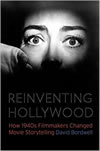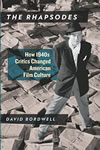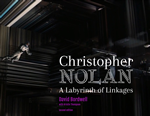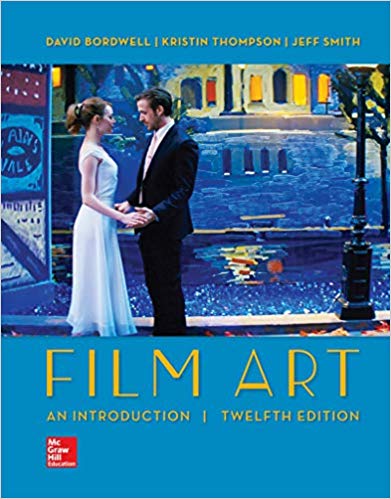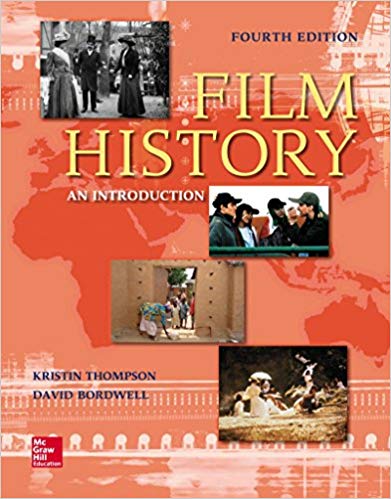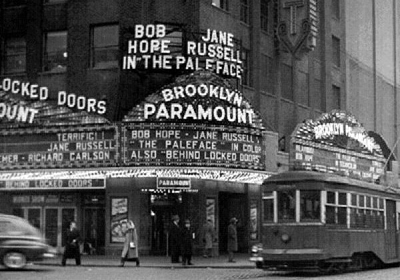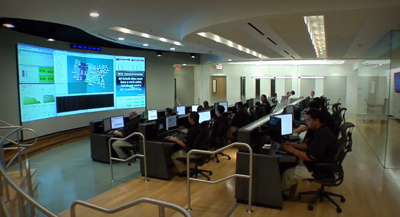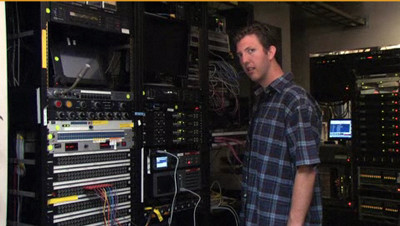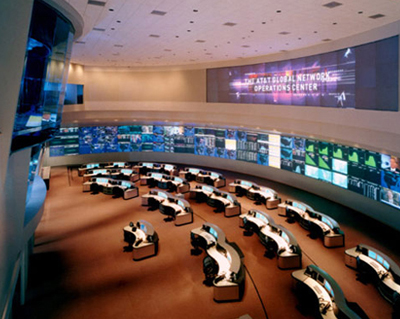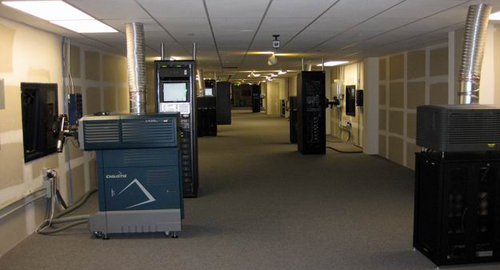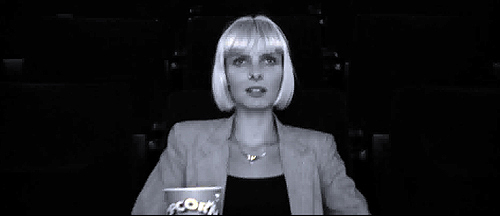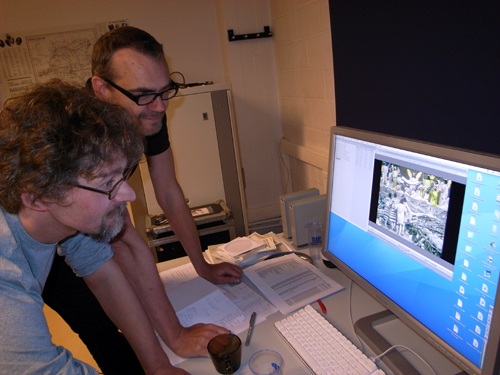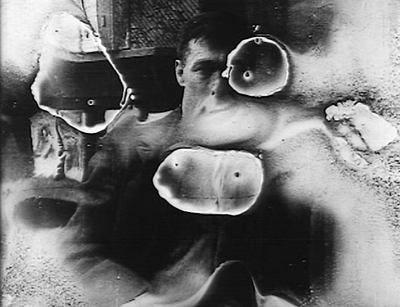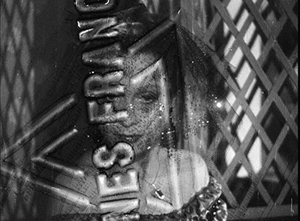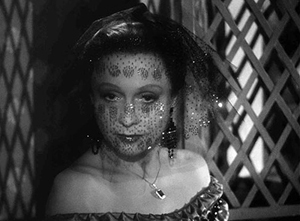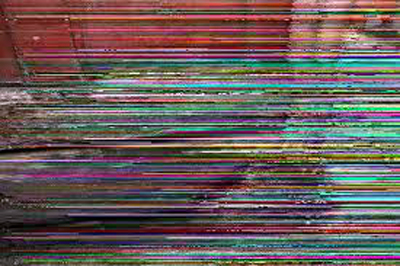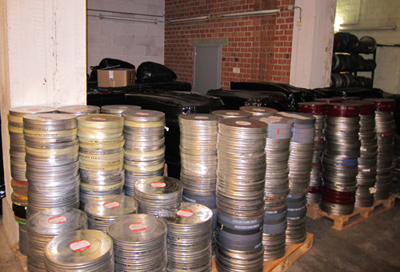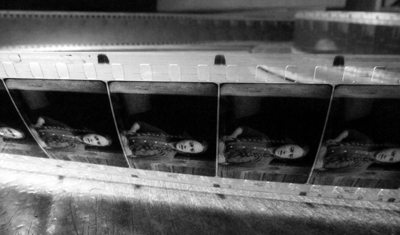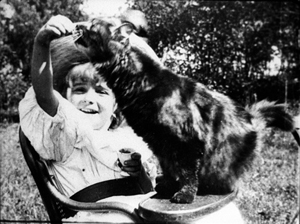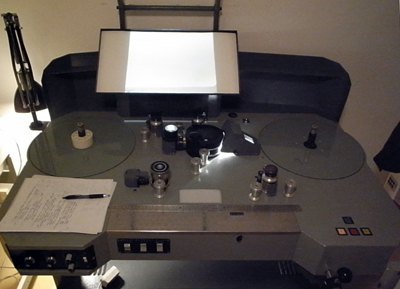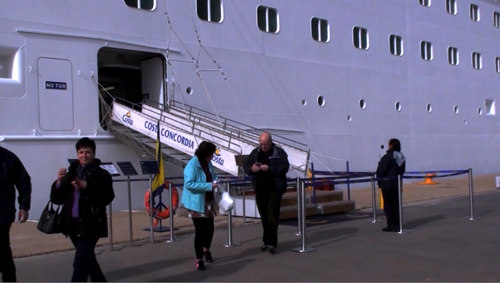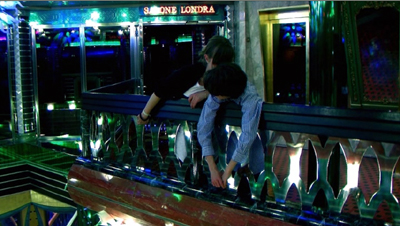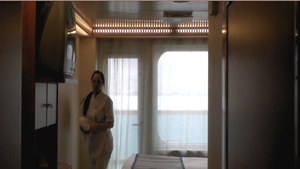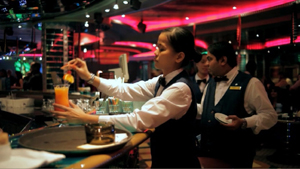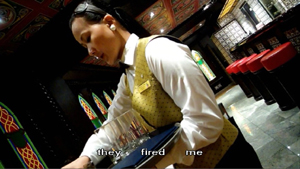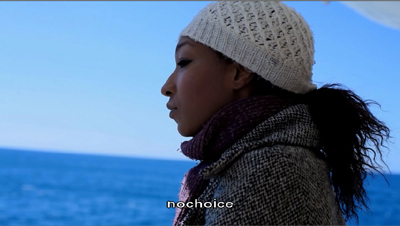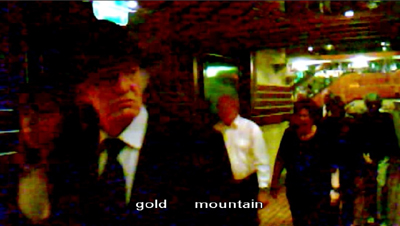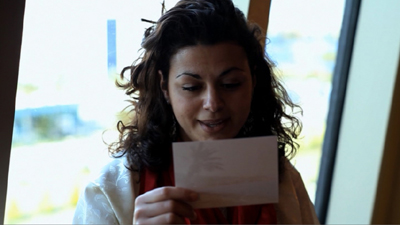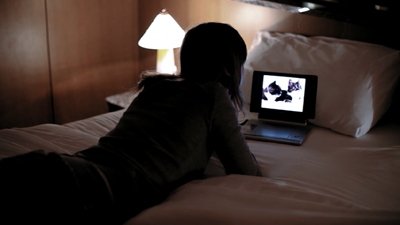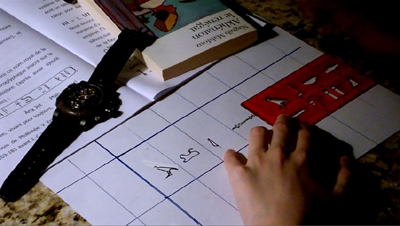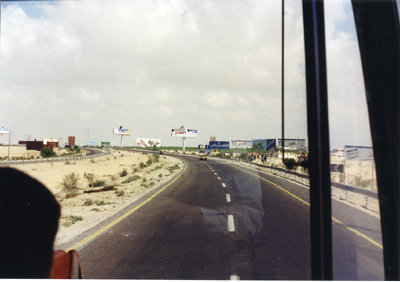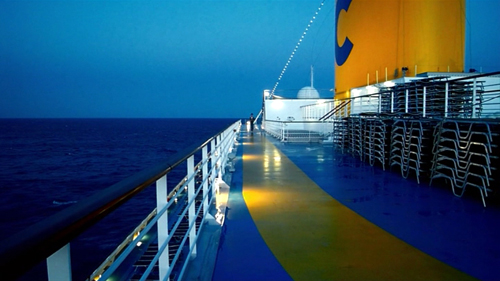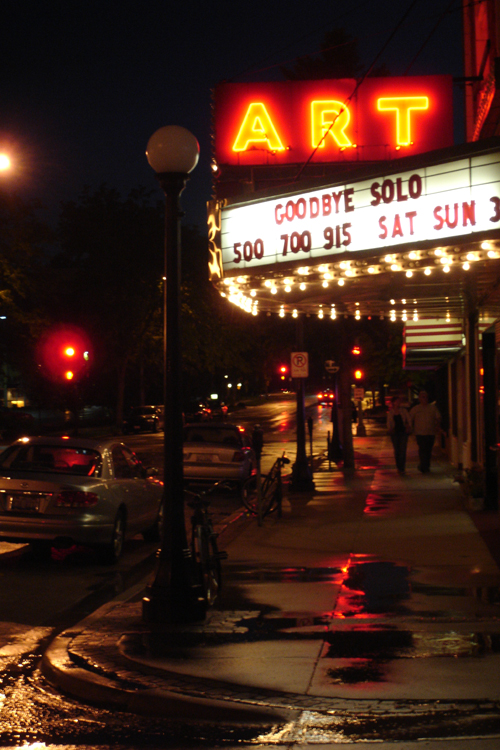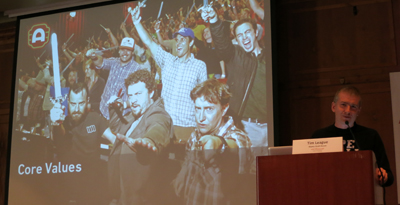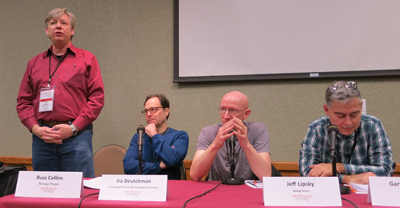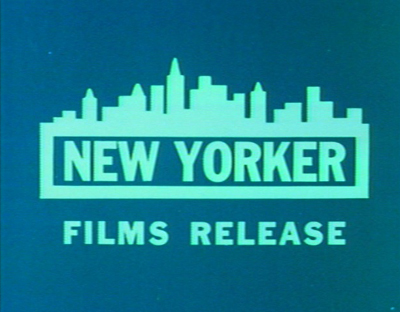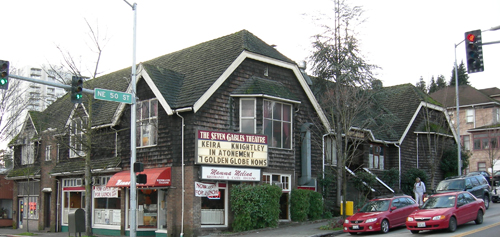Archive for 2012
Pandora’s digital box: Notes on NOCs
A video-wall display in the Christie Network Operations Center, Cypress, California.
DB here:
You’re in a multiplex. The pre-show attractions are large, loud promotions for TV shows, pop music, and star careers, interspersed with ads for men’s cologne and local pet-grooming facilities. Then comes the theatre chain itself telling you to hush up, turn off anything that emits light or sound, take your feet off the seats in front of you, and buy some popcorn. Next comes a barrage of trailers. Sooner or later the movie starts.
If you look back at the projection booth, will you see another human being? Not necessarily. It’s possible that everything that happens in your theatre is automated.
Now imagine another space, a large room with ranks of work stations. A couple of dozen people sit before their monitors, facing a video wall. From a room like this in Omaha, Nebraska, or in Cypress, California, or in Liège, Belgium, or in Shenzhen, China, these workers can remotely track thousands of theatre screens, including yours. It’s another consequence of the emergence of digital projection in our movie theatres.
Command and control
Brooklyn Paramount Theatre, 1948, from the splendor that is Cinema Treasures.
One of the many lessons you learn from Douglas Gomery’s magisterial history of the Hollywood studio system is straightforward. For about a hundred years, film producers and distributors have sought to control exhibition.
The advantages are obvious. Controlling exhibition keeps competitors off screens, it yields more or less assured revenues, and it allows vast economies of scale. If you can count on 2000-4000 screens playing your movie, as is common for Hollywood releases today, you can budget your production accordingly.
From the 1920s through the 1940s, studio control was quite direct. The Big Five companies (Paramount, Loew’s/MGM, 20th Century-Fox, Warner Bros., and RKO) wholly or partially owned hundreds of theatres, and these served as display cases for their product. Because no studio could supply all its theatre chains with films, studios shared their screens with their peers and kept other companies’ films out. “Here,” Gomery writes, “was a collusive oligopoly (control by a few) that operated as an almost pure monopoly.”
The studios didn’t own most of America’s theatres, just the most profitable ones. The thousands of independent houses and chains were subjected to studio control in more indirect ways. The studios forced the independents to book films in batches (“blocks”). To get prime releases, the exhibitors had to take weaker titles. Likewise, the independents had to bid for upcoming releases without being able to see them.
The structure of the market was another strategy of control. Adolph Zukor pioneered the system of runs, zones, and clearances. If people wanted to see a new release immediately, they had to pay top dollar at a first-run theatre. After a certain interval, the clearance, the movie would play a second run theatre in another territory at a lower price, and so on down the food chain of movie houses.
Technology was another strategy of control. The 35mm film standard wasn’t proprietary, but the sound systems that the studios adopted in the late 1920s were. Of the dozens of systems, only two became standardized: Western Electric and RCA. In a process similar to what’s happening today, theatres were forced to install one system or the other. The thousands of screens that couldn’t afford the new technology went dark.
This system worked to the Big Five’s benefit until 1948, when the Supreme Court declared Hollywood’s vertical integration monopolistic. The studios chose the wisest way to break up, given the slump in admissions: They divested themselves of their theatres and concentrated on production and distribution. (The process took several years in some cases, and there often remained close unofficial ties between the Majors and their former circuits.) In addition, block-booking and blind bidding were outlawed, so some market factors became more favorable to exhibitors.
The postwar studios occasionally tried to remake exhibition through new technology. CinemaScope, designed by 20th Century-Fox, sought to become the industry standard for widescreen presentation. Although there was considerable take-up, it had competition from other systems (notably Paramount’s VistaVision) and exhibitors were able to wring concessions from Fox. Centrally, exhibitors were reluctant to install magnetic stereo playback, and so Fox had to compromise by producing prints that could play on optical sound systems as well. Similarly, while various 70mm formats were tried, none became obligatory for exhibitors, since films released in 70 were also released in 35, if only in later runs.
Of course Hollywood still had a desirable product and could charge dearly for it, so stiff contracts for revenue returns gave studios considerable power. In the 1970s, the Majors (which no longer included RKO and had expanded to include Disney, Columbia, and Universal) found another way to use market dynamics to control exhibition. To publicize Jaws (1975), Universal launched massive television advertising and avoided the “platforming” or “exclusive engagement” practice. Studio chief Lew Wasserman opted for “saturation booking,” releasing Jaws on over 400 screens simultaneously. A month later it expanded to over 600.
The growth of the blockbuster, nurtured by Star Wars, Superman, and other huge hits, encouraged theatre chains to build multiplexes. The distributors could then blanket screens with their product. Exhibitors could realize economies of scale by holding over some movies for months while rotating regular releases through other screens.
With the arrival of cable, satellite transmission, and home video, studios were able to maintain tiers of price discrimination. The theatrical opening became the loss-leader, making less revenues but establishing buzz for the ancillary market. Theatrical runs were shortened considerably, but the “windows” of video distribution became the equivalent of second- and later runs. A movie becomes available on Pay Per View, then VOD and/or DVD, then premium cable, and so on. The windows’ length and ordering have changed over the years, but throughout, by carving up the market by price discrimination the studios continued to rule exhibition patterns.
My account makes recent history too neat, with studios apparently steamrollering unprotesting exhibitors. In fact, exhibitors have responded to some pressures by dragging their feet or pushing back. Better sound systems took some years to penetrate the market. Some big theatres refused to play Star Wars Episode I: The Phantom Menace because of onerous terms, including a minimum guarantee and a commitment to a lengthy run in a ‘plex’s biggest auditorium. More recently, studios’ efforts to shorten windows and release films sooner on DVD or on VOD have sparked resistance.
Studios have periodically tried to become vertically integrated again. There were some attempts in the 1980s to run theatre circuits, but only Viacom has found success owning both Paramount and the National Amusements chain. Today, technology is providing a more effective lever–or rather a crowbar. Digital projection furnishes the most thoroughgoing opportunity for studio control over exhibition since the coming of sound, and perhaps since the days when the Majors owned movie houses.
NOC, NOC, who’s there?
Christie Network Operations Center, Cypress, California.
My first entry in this series considered the power of setting standards, something Hollywood has been good at for decades. In 2005 the Majors established the technical specifications for the Digital Cinema Initiatives. As has happened throughout history, they had the input from the powerful manufacturers, service companies, and professional associations, like the SMPTE and the American Society of Cinematographers.
Once the standards were set, the projection and service suppliers could move forward with appropriate equipment. The conversion is expensive, so exhibitors have been offered the option of signing up for a Virtual Print Fee. This is a partial subsidy from the major companies that is passed through an “integrator,” a third-party company that attends to acquiring the equipment, installing it, and monitoring payback.
A decade ago, over a dozen significant US theatre chains filed for bankruptcy protection, so costs are constantly on exhibitors’ minds. Digital projection offered multiplex operators the opportunity to cut staff. Screening film prints is somewhat technical, and it relies on mechanical skills that are growing rare. So anything the manager can do to simplify running the show is welcome. Movies on digital files filled the bill. A film projectionist, represented by what was once one of the more powerful unions around, is expensive. Teenage labor is not.
Digital works for the fresh-faced novice. Once the film comes in on a hard drive, it’s not terribly hard to set up a show. Disney has made a couple of remarkable instructional films (here and here) for the new projector operator Jimmy, who wears the requisite Bob & Ted apparel.
In the old days, Walt would have given us a cartoon, and Goofy would have been the star.
Jimmy loads the movies, and he or the manager sets up the programs. Once the features, the trailers, and the ads are on the servers or the library system, the theatre manager can program every screen. From a computer in the manager’s office, or almost anywhere, he or she can build each auditorium’s playlist by dragging and dropping. If the arrangements with the distributor permit, the files can be migrated from screen to screen.
Even under these conditions, though, you need minimal maintenance. Projector lamps must be changed, for instance. The installers or a local expert can supply routine maintenance, but sometimes there are problems. An encrypted file can’t be opened, or it’s corrupted, or the show mysteriously stops. Very likely Jimmy, even consulting his manual, can’t fix the problem.
Enter the NOC.
Network Operations Centers, also known as Data Centers, are part of broader Information Technology management. They’re used whenever a business or government agency has a network that needs 24/7 monitoring. All Fortune 1000 companies have NOCs, and probably have mirror backups of them scattered around the world. NOCs coordinate railway systems, military systems, banking, and police and fire departments. Amazon has a NOC in Seattle, Wal-Mart has one in Bentonville, Arkansas, and AT&T has a monstrous one in Bedminster, New Jersey (below).
There’s a nice gallery of NOCs here.
Don’t confuse NOCs with call centers or help lines. NOCs are handling and storing vast streams of data from computers, cameras, and other inputs. The goal is keeping track of things pertinent to the business or agency. But of course even large staffs can’t do this simply by eyeballing the flood of data. Instead, the software is set to notice anomalies and to call them to the attention of the humans. So if a police camera outside a Tube stop in London picks up a pattern of unusual activity, say three men running purposefully toward a woman, that information is pulled out of the stream and sent to an operator for inspection.
Once film theatres became digital, they acquired the ability to connect to NOCs via the Web. An owner who funded the purchase of the DCI-compliant equipment might well choose to pay a NOC to provide oversight and help. Exhibitors who sign up for a Virtual Print Fee program are required to sign up for a NOC. NOC services may be supplied by the equipment manufacturer (Sony, Christie’s, Barco, GDC et al.) or by the installer, such as Ballantyne Strong (Omaha) or Film-Tech Cinema Systems (Plano, Texas). An integrator may also offer NOC services, as Cinedigm does in the US and XDC does in Europe.
By the standards of giants like AT&T, a theatre-monitoring NOC tends to be fairly small, as my pictures indicate. Still, the purpose is the same. Each projector/ server combination and theatre-management system (essentially a master server) is connected via the internet to the NOC. The NOC monitors the state of the system, so that, for instance, it can keep track of lamp life, parts conditions, net connectivity, and the like. The software can send alerts to the theatre management for upcoming maintenance and can do troubleshooting. It’s also trained to notice problems—glitches in playback, lights going on, dropped subtitles, or whatever. Anomalies are called to the attention of the specialists at the work stations.
The projector manufacturer Christie’s initiated one of the first NOCs in 2003, and it now monitors over 3700 digital screens across the US and Canada. From its California facility it “manages the configuration of systems, provides help-desk services to customer staff, and access to local technicians with local parts to provide on-site repair and support.” The Shenzhen center maintained by GDC, a server company, monitors ten thousand screens. Most NOCs don’t plan programming or chase down encryption keys from distributors, but the NOC maintained by Film-Tech will perform these services as well. It will even power up and down the auditorium. With the Film-Tech system in place, says the company’s brochure, “The projection booth can literally operate for months without anyone ever entering it.”
The show must go on, if remotely
The projection area of the Studio Movie Grill City Centre, Houston, announced as the world’s first completely automated booth.
Now Jimmy and his manager have substantial support, but in turn they’ve shared a lot of information with the NOC. In order to collect the Virtual Print Fee, the exhibitor must play the studio’s film on a contractual basis—for a certain period, a certain number of times per day, and so on.
In earlier times, a dodgy exhibitor might run a film more frequently than was reported back to the distributor, with the exhibitor pocketing the difference. Or an exhibitor might trim shows of a poorly performing title, substituting something more popular and depriving the weak film of playing slots and box-office payback. In the pre-digital days, distributors sent out “checkers,” staff disguised as ordinary moviegoers, to see that theatres were running films according to the booking.
Now the projector/server mating provides real-time screening information to the NOC, and that flows to the distributor. Says an executive at a firm supplying NOC services:
All of the NOCs notify the studios about the performance of the systems. Uptime is critical or VPFs will not be paid. Exhibitors cannot miss more than a certain number of allotted shows and still receive their checks. . . . All NOCs provide the studios with access to the playback logs to ensure the movies booked are actually played.
According to the same source, some NOC systems monitor the use of the equipment outside normal shows. “Some of the traditional NOCs go so far as to ensure the equipment is not used for anything else, and the theatre will be back-charged for the use of that equipment.”
At a minimum, then, the performance information forces the exhibitor to abide by the booking contract. But it also means that even with full knowledge on the part of both exhibitor and distributor, the advantage lies with the distributor.
For example, if an exhibitor wants to play a film from outside the Majors, even if that film is available on a DCI-compliant file, that distributor has to pay a VPF. From the standpoint of the studios and the supply companies, he who pays the piper calls the tune: A DCI-compliant projector shouldn’t be used by free riders who didn’t participate in the DCI. Why should the Big Six establish the standard and fund the purchase and installation of the gear in order to play a competitor’s film? If the exhibitor dares to proceed without the VPF and uses the equipment to show unauthorized product, that information flows back to the NOC.
Consider as well the practice of “splitting.” Smaller theatres and art houses often adopt the multiplex tactic of offering many titles, but for them that entails showing two or more films on the same screen in a given day. Often splitting is done with the advance permission of the distributor, but sometimes it’s done ad hoc and reported after the fact (unlike the dodgy practice of show-shuffling I mentioned above). But VPF conditions may forbid splitting altogether. And if the exhibitor is obliged to do it, as when one movie file fails to run and another must replace it, the NOC will flag it.
Distributors allow a certain leeway for quality checks, running a film at odd hours to make sure it plays properly. Still, the NOC is tuned to those anomalies too. One exhibitor remarks, “If I’m demoing a movie, they may not know it’s a demo. They might wonder why I played a movie at 9:30 AM.”
In a highly automated environment, things can proceed blindly. There’s a story (not apocryphal, I think) about an early automated theatre system here in Madison, Wisconsin. During the 1970s, a snowstorm paralyzed the town, but someone at a theatre had left the system on. Even though the theatre was closed (and no one could get to it), the show went on: lights up, lights down, curtain parts, film runs, film halts, lights up, film rewinds….
More vaguely, some exhibitors worry about the NOC as a policing or surveillance operation. No one can object to a mechanism that enforces contracts, but film screenings have long had a certain fluidity, especially in the art-house realm. On-the-fly compromises and flexible arrangements emerged from negotiations among managers, programmers, bookers, and distribution staff. People knew one another and made allowances for specific circumstances. When so much of scheduling and operation is transferred to servers, playlists, and NOCs, human contact is likely to wane. The projectionist isn’t the only ghost haunting the multiplex.
Anyone who has ordered something with a credit card online has already submitted to the oversight of a NOC. But when your livelihood depends on smoothly functioning film screenings, you could be understandably apprehensive about turning your business over to unknown others in unknown places. Hacking, malware, and human error are spectres hovering over all of IT. As one theatre owner told me: “[The NOC] could shut off every theatre at one time and in the process send a little message, like the Jolly Roger in Independence Day when the guys bugged the mother ship.”
The studios innovated technology and had the power to set standards and restructure the flow of product. The multiplex exhibitors wanted to cut costs and simplify presentation. This meshing of interests allowed Hollywood studios to control exhibition to a new degree. Who wants to own theatres anyway? They entangle you in mortgages and real estate crises, and they have the awkward habit of going into bankruptcy. In addition, the Majors could win over local exhibitors by upcharging for 3D and by supplying ad packages that generate more income. Today if you control the files, the encryption, and the network, you control the show.
What’s left for the managers? Well, there’s selling popcorn.
This is the seventh in a series of entries on the conversion to digital projection in cinemas.
Thanks to Douglas Gomery, whose work on the American film industry has guided my thinking for the years going back to our teaching together at Madison in 1973. The place to start is his superb book The Hollywood Studio System: A History, which is complemented by his Shared Pleasures: A History of Movie Presentation in the United States. I’m grateful as well to those exhibitors and service specialists willing to share information with me, as well as to Jenn Jennings, who is making a film about the digital transition, and Jim Cortada of IBM and the Irvington Way Institute.
The Film-Tech Forum is an informative chatroom concerning projection and general film matters. Examples of NOCs in action have been provided in videos by Christie and XDC. In the latter, and true to European sophistication, our fashion-challenged Jimmy is replaced by a woman with bangs and a discreet nose ring. Yet like you and me, she likes a snack.
Pandora’s digital box: Pix and pixels
Peter Rotsaert and Vico De Vocht examine a digital version of a silent film at the Brussels Cinematek.
DB here:
Today Dawson City, in the Yukon Territory of Canada, has fewer than two thousand people, but in the 1890s tens of thousands passed through in search of gold. Movies came along too, but the remoteness of the place made it the end of the line for most prints. Many were stored in the basement of the Carnegie Library. In 1929, an enterprising bank worker shifted them to an abandoned swimming pool. The stacks of films were covered with planks, and they were in turn covered by earth, so the films were buried in the permafrost. The surface became an ice hockey rink.
In 1978, builders discovered the film cache. Sam Kula, then an archivist at the National Archives of Canada, stored the films temporarily in an ice house. The painstaking process of checking each reel began. Eventually the US Library of Congress was brought in because most of the 507 reels discovered were American. Among the finds were a Harold Lloyd short, a great deal of news footage, and a rich array of serials starring heroines of the 1910s.
Wellington, New Zealand, was another terminus for American movies during the old days. In 2009, a film preservationist from the Academy of Motion Picture Arts and Sciences learned that the New Zealand Film Archive held a lode of Hollywood films. The collection, reviewed here, includes many Westerns and Christie comedies, along with John Ford’s supposedly lost Upstream (1927). The restored Upstream played in festivals and special screenings during 2010 and 2011. Five American archives have been involved in restoring the seventy-five titles selected for repatriation.
Whatever the merits of the films revealed—literally unearthed, in the Dawson instance—discoveries like these are signs of hope. Who knows how much more of our film heritage remains to be rediscovered? For this reason, George Eastman House archivist Paolo Cherchi Usai prefers to list a film not as “lost” but rather as “not yet found.”
Given such discoveries, the archivists will set to work creating usable and enduring versions. But today such a task is much harder. Soon most of the films we make and show will not exist on photochemical stock. They’ll be digital files, and they need to be kept securely. But how?
Will today’s typhoon of ones and zeroes rip away our analog past? Will there ever be a digital Dawson City, a stockpile of files of lost movies? It seems likely that digital projection has, in unintended and unexpected ways, put the history of film in jeopardy.
Digital restoration: A success story
Nitrate decomposition; from Bill Morrison’s Decasia: The State of Decay (2004).
Of the tens of thousands of feature films produced worldwide in the silent era, approximately ten per cent survive.
Jan-Christopher Horak, Director, UCLA Film and Television Archive
The archives I’m speaking of are either public ones, like the Library of Congress, or privately supported ones like Eastman House and the Museum of Modern Art. These and hundreds of smaller archives are nonprofit institutions charged with protecting images and sounds we’ve deemed of cultural value. By contrast, a studio-based archive aims to maintain the firm’s investment in its property. Often studios deposit films of historical importance at nonprofit archives; some countries require by law that copies of films circulated there be deposited in the national archive. Both sorts of archives have done excellent work, but I’ll be talking largely of the nonprofit ones, which often receive films by donation, deposit, purchase, or accident.
Archivists distinguish between conserving and preserving. You conserve a film by taking it into the archive and storing it safely in temperature-and-humidity controlled vaults. You preserve it by cleaning and patching it, and if necessary transferring it to a more stable medium. Restoration, which is the archival task most visible to the film-loving public, goes further. It involves working to bring the film back to something like its original state.
Before the 1970s, archives conserved and preserved, but seldom restored. Archivists at public institutions balanced two duties: keeping films safe for the future and screening them for the public and researchers. Like art museums, archives guarded treasures while putting some of them on display.
Most often, archives preserved their material by making the best possible copies. A big part of the job was migrating films from one format to another. For example, some early American film companies copyrighted their product by submitting rolls of paper on which each frame of film had been printed. These “paper prints” had to be transferred, frame by frame, to motion-picture film. Likewise, films surviving only in rare formats, like 9.5mm, 22mm, and 28mm, had to be transferred to 35mm so they could be run on standard equipment. Tinted films on nitrate were reprinted on black and white safety film. 16mm films might be blown up to 35mm, and 35mm might be reduced to 16mm for circulation to schools, libraries, and film clubs.
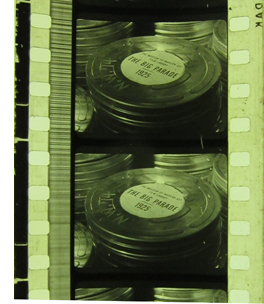 Most famously, thousands of films in archive collections exist on nitrate stock. That was the professional standard before 1950 or so, when the industry abandoned it. Not only did nitrate film have a habit of exploding or catching fire, but it tended to decompose. Experimental filmmakers have found a sinister beauty in ruined footage, but archivists organized for funding to help transfer their collections to acetate. Then archivists learned that some acetate prints degenerated into a vinegary, contagious vapor. So migration to a new, polyester-based stock became necessary.
Most famously, thousands of films in archive collections exist on nitrate stock. That was the professional standard before 1950 or so, when the industry abandoned it. Not only did nitrate film have a habit of exploding or catching fire, but it tended to decompose. Experimental filmmakers have found a sinister beauty in ruined footage, but archivists organized for funding to help transfer their collections to acetate. Then archivists learned that some acetate prints degenerated into a vinegary, contagious vapor. So migration to a new, polyester-based stock became necessary.
Preservation, simply keeping films alive in long-lasting formats, remained central to archives. In the 1970s a number of archivists also began restoring films. For example, most silent feature films were released in tinted and toned prints, but many copies survived only in black-and white. Restorers, guided by surviving paper records, aimed to create prints that approximated the original color schemes.
Restorers naturally faced decisions about what would count as an original. In 1989 there were six different versions of Mr. Smith Goes to Washington, running from 119 minutes to 132 minutes. In uncertain cases, records of running times and postproduction work helped identify what was missing. If the footage couldn’t be found, still photos or even a blank screen might cover the gaps, as in restorations of Greed and the 1954 A Star Is Born. A musical score helped researchers measure how much footage from the original Metropolis remained to be found.
With the rise of cable television and home video, studios’ film libraries became more valuable. Ted Turner, owner of the MGM, Warner, and RKO libraries, was blamed for “colorizing” some classics for his cable channels, but at the same time he invested in restoring a great many of them. Other firms followed suit. Gone with the Wind and Disney perennials were reworked for cable and VHS release.
The 1980s and 1990s became the great age of restorations. Audiences were reintroduced to Napoleon, Becky Sharp, Lawrence of Arabia, and Vertigo. Kevin Brownlow and David Gill, working with Thames Television, reissued silent classics, with new scores by Carl Davis. Most of the era’s restorations wound up on video platforms. Today Turner Classic Movies is our great display case for studio and off-Hollywood restorations; it’s the closest thing we have to a Citizen’s Film Library.
At first, restoration was a photochemical affair. Every major archive employed experts in rephotography and lab work who knew how to optimize the look of a print. Archivists like Noël Desmet collected information about properties of old film stocks and tinting dyes. Faded films could be reprinted through filters that might bring back some of the old snap. The look of old films was much improved by wet-gate printing, which bathed the frames in a liquid that masked scratches on the base or emulsion.
But not much could be done about the blotchy nitrate decay that might invade a scene, or the dirt and dust that earlier copies of the film bequeathed to the current one. And those films for which no original negative could be found, including Citizen Kane and Singin’ in the Rain, would always be seen as the shadow of a shadow—new copies pulled from earlier, perhaps shabby ones.
The upside was that as long as you kept your source prints and your restorations on 35mm film stock in a cool, dry place, you had material that would last over 100 years. Some day you might find better tools for improving what you had.
That day came fairly soon. The Disney company had a steady income from theatrical and video re-releases of its animation classics, and a 1990 reissue of Fantasia employed some video-paint work to correct flaws in the frames. Snow White and the Seven Dwarfs was then given high-resolution treatment. Dust-busting and color adjustments were made frame by frame. Re-released in 1993, Snow White was the first feature to be restored digitally.
Since then, digital fixups have become a standard method for archival restoration. Footage is scanned into a file at 2K or 4K resolution. Either manually or automatically, the software can correct for jumpy or shaky imagery, do dust-busting, erase scratches, and balance exposure, contrast, and other factors. It can interpolate image areas in order to correct damages in the frame, and it can add tinting or toning. The finished files may then be saved as files or scanned back onto film, as Snow White was. You can see an example from the newly restored Marcel Carné film, Children of Paradise (Les Enfants du paradis).
Soon most restorations are likely to be finished and screened on digital formats, with virtually no 35mm prints circulating.
Born-digital, born-again digital?
Decay of digital imagery, from Creative Applications.
The preservation of born-digital films is going to be the greatest challenge ever to face archivists.
Margaret Bodde, Executive Director of the Film Foundation
The new magical software has sometimes led to over-restoration. Grain has too often been polished out, creating a plastic sheen. Still, today no archivist can avoid using the new toolkit. The sadder story involves not restoration but conservation and preservation. A civilian might think: That’s simple. Just save film on film and digital on digital. But things are more complicated than that.
Let’s start with a movie like The Girl with the Dragon Tattoo, which was shot with digital capture. After production and post-production, it was made available to theatres as both a Digital Cinema Package (that batch of files on a hard drive) and some 35mm prints. But there are several digital versions of the movie.
Digital source material. The original sound and image “content” may be captured in specific formats, either tape-based or file-based. Those formats can vary a lot among themselves. The Girl with the Dragon Tattoo, for example, was shot with the Red One camera on the company’s proprietary format R3D. Other cameras don’t use that format. So the footage was converted to other sorts of files for viewing and postproduction work.
Any major film nowadays is likely to use many digital video and audio formats. All these assets are usually stored in the distributor’s vaults.
The Digital Source Master (DSM or DCM). This is the master copy of the finished film, somewhat comparable to a 35mm film negative. It can be in any format selected by the filmmakers. It’s the basis of the distribution master, the home video master, and a master version for archival storage.
The Digital Cinema Distribution Master (DCDM), in formats determined by the Digital Cinema Initiatives. This is the finished film unencrypted and uncompressed, providing “content” at 2K and/or 4K resolution. Roughly speaking, this is the digital counterpart of a 35mm release print.
The Digital Cinema Package (DCP). This is the film compressed and encrypted for theatrical playback. It’s roughly comparable to the delivery of a 35mm print on shipping reels.
The Digital Cinema Distribution Master as played (DCDM*) Once the DCP files are opened and decompressed, they yield image and sound identical to what’s encoded on the DCDM. The DCDM*’s place in the system is somewhat parallel to the projection of a 35mm print from platters.
Eventually, The Girl will show up on the optical disc formats DVD and Blu-ray, not to mention streaming video, cable transmission, and web-based platforms. (Actually, it’s probably already available for Darknet download.)
Many studio films are housed in nonprofit archives too, and until recently those movies have been deposited and stored as analogue copies. But what will those institutions now keep? There are only three minimally acceptable formats: the uncompressed and unencrypted DCDM, the DCP, and a 35mm print. Suppose your film archive is lucky enough to receive both a DCP and a 35mm print of The Girl.
First, how do you access the DCP files? A DCP is typically encrypted to block piracy. When The Girl played theatres digitally, each exhibitor was provided an alphanumeric password that would open the files for loading into the theatre’s server. By the time you the archivist get the files, that key may have expired or been lost. Without the key, the DCP is useless.
Then there’s the matter of storage. The 35 print of The Girl can simply be passively conserved, following the motto, “Store and ignore.” But all digital material, no matter how minor, requires proactive preservation. The future for digital storage is constant migration.
Archivists estimate the life of any digital platform to be less than ten years, sometimes less than five. All hard drives fail sooner or later, and they need to be run periodically to lubricate themselves. Tape degradation can be quite quick; one expert found that 40 % of tapes from digital intermediate houses had missing frames or corrupted data. Most of the tapes were only nine months old.
Moreover, hardware and software are constantly changing. One archivist estimates that over one hundred video playback systems have come and gone over the last sixty years. Archives currently recognize over two dozen video formats and over a dozen audio ones.
Periodically, then, the DCP files of The Girl will have to be checked for corruption and transferred to another tape or hard drive and eventually to another digital format. Such maintenance takes time; shifting a terabyte of data from one system to another may need at least three or four hours. Ideally, you’d want several copies for backup, and you’d want to store them in different locations.
There are hundreds of other films like The Girl awaiting processing at major archives. About 600-900 feature films are produced in the US each year. Currently the world is producing about 5500 features per year. At some point, they will all originate in digital capture.
Besides access and storage there’s the matter of cost. Storing 4K digital masters costs about 11 times as much as storing a film master. You can store the digital master for about $12,000 per year, while the film master averages about $1,100.
How do the overall costs of digitizing mount up? Look at the situation in Europe. The EU countries produce about 1100 features and 1400 shorts per year. An EU archival commission, the Digital Agenda for European Film Heritage, estimates that to conserve one year’s output would require 5.8 PB (petabytes) of storage. In 2015, the costs of archiving that year’s output (without restoration) are projected to be between 1.5 million and 3 million euros. Beyond initial conservation, long-term preservation of that year’s output would consume, though migration and backing up, about 1900 PB and cost about 290 million euros.
The access problem is soluble. Your archive could be given an unencrypted DCP of The Girl and then create its own key to prevent copying. Or the DCP could be assigned a generic key, perhaps for a specified time period, that will open the files in a secure milieu. They could then be migrated to a format under archive control. On the matter of software, archivists are working on establishing standard preservation file formats and codecs. To deal with the other problems, you’d have to press for increased budgets and personnel to cover the new duties that digital archiving creates. But the costs, including training personnel on ever-changing platforms, are of tidal-wave proportions.
Photochemical Armageddon?
The methods we have for securely storing comprehensible digital data are highly labour-intensive. Humans are too slow and they cost too much.
Bruce Sterling, science-fiction writer
So why don’t you preserve The Girl’s files on film? Film is universally recognized as the most stable platform for moving-image material. Properly stored, a film print can last a hundred years or more. Maintaining a print, as we’ve seen, is cheaper than maintaining digital files. It’s significant that the archives of most of the major studios continue to transfer all their current features to film via color separations on polyester stock.
Apart from the costs of making file-to-film transfer, which can amount to tens of thousands of dollars, the long-range problem is technology. The same forces that shoved out 35mm projection have made 35mm preservation much harder. The equipment for outputting digital files onto film will eventually cease to be available. With the rise of digital projection, demand for film stock plummeted. Eastman Kodak’s recent bankruptcy filing reflects the declining market for raw film, and even though Fuji promises to continue to make 35mm stock, it is likely to get more expensive. As David Hancock of IHS Screen Digest points out, the cost of silver, a necessary component of raw stock, is rising steeply after being low for many years.
Sensing a niche market, Kodak has announced that it will provide a new emulsion favorable to archival preservation. But at the moment, laboratories that can process and print any film stock are closing. Not for nothing does Nicola Mazzanti, Director of the Royal Film Archive of Belgium, suggest that an archive should consider buying a lab, which is likely to be available at a low price.
If preserving on film is increasingly unlikely, how about preserving on digital formats? Perverse as it sounds, can you take your 35mm print of The Girl with the Dragon Tattoo and store it as tape or files? Yes. This is called “digital reformatting.” Once film has been scanned, archives can make DCPs at low cost. But the initial scanning is costly, and high-end 35mm scanners, though still in use to make Digital Intermediates for 35mm releases, are likely to be costly for nonprofit archives. In any event, saving film digitally puts us back to the problems of digital conservation and preservation: cost, storage, maintenance, and access. (Surely the rights holders will want the archive to encrypt its home-made DCPs.)
Preserving on film may simply postpone Armageddon. As the most recent European report of the Digital Agenda for European Film Heritage concludes:
As a solution [digital migration to film] will only be viable as long as the analogue film ‘ecosystem’ (equipment, film stock, laboratories) exists. Instead of being a long-term solution, the risk is that it becomes a very short term one. In the long term it will make problems worse as it will increase the number of works that need to be digitised in the future. . . . At 25,000 euros to 100,000 euros per feature film, the going-back-to-film solution appears to be 20 to 80 times more expensive than digital preservation.
It’s hard to get your mind around the scale of the problem. Here is Ken Weissman of the Library of Congress:
Speaking very broadly, with 4K scans of color films you wind up in the neighborhood of 128 MB per frame. . . . Figure that a typical motion picture has about 160,000 frames, and you wind up with around 24 TB per film. And that’s just the raw data. Now you process it to do things like removing dust, tears, and other digital restoration work. Each of those develops additional data streams and data files. We’ve decided, based upon our previous experience, that it is best to save the initial scans as well as the final processed files for the long term. Now we are up to 48 TB per film. In our nitrate collection alone, we have well over 30,000 titles. 48 TB x 30,000 = 1,440,000 TB or 1.44 EB (exabytes) of data.
Weissman adds with a trace of grim humor: “And of course you want to have a backup copy.”
The girl with the photochemical tattoo
I think that film-on-film projection will ultimately become the sole purview of archives and museums.
Michael Pogorzelski, Director of the Academy of Motion Picture Arts and Sciences Film Archive
Once you’ve found a way to conserve-preserve The Girl with the Dragon Tattoo, what if you want to show it tomorrow? Or ten years from now? Or fifty?
If you have a DCP in good shape, and a projector that will show 2K/4K according to the Digital Cinema Initiative standard, you’re good to go. For now. But maybe not tomorrow.
Once the projector/ server market has saturated and everybody has DCI-compliant equipment, equipment manufacturers and software designers have to keep innovating to sell new machines. Many observers expect the D-cinema standard to be recast in the next ten to fifteen years, and projectors may be redesigned sooner than that. Mazzanti anticipates that there will be 8K resolution, greater bit depths, faster frame rates, laser projection, new sound formats, and other advances. Already innovations are leapfrogging DCI standards: last month, a new generation of projectors was showcased. If you program your digital version of The Girl for its twenty-fifth anniversary in 2036, you will probably have to reformat it for whatever your projector can then play.
So instead you hold on to your 35mm print. That will give you cachet, because within a decade all commercial cinemas will be digital, and, as Mike Pogorzelski mentions, only archives will show 35. But cachet takes cash. Archives, at least the major ones, will have to retain their 35mm inspection and projection gear, even though that will probably cease to be made and parts will be cannibalized. You’ll need vigilant, resourceful staff who know how to fix old machines.
Moreover, with the scarcity of raw stock and the shuttering of laboratories, archives will be less likely to make screening copies of their holdings. Virtually every 35mm copy you the archivist hold, from Red Desert to a Bowery Boys movie, becomes irreplaceable, what Mazzanti calls a “unique master.” Then film archives will truly become film museums, custodians of extremely rare artifacts.
At some point no one may risk running analog film, as the damage would be irreparable. In that worst-case scenario, archives will show digital copies, either derived from prints or supplied by whatever sources they can find (including, yes, Blu-ray or whatever comes after). One consequence may be the freezing of the canon. We’ll get more and better versions of old standbys like Metropolis and Napoleon, but less effort to retrieve lost or ignored items from scratch. New discoveries may simply be too expensive to maintain, especially if they lack the crowd-pleasing appeal of the most famous classics.
I biased the case by taking as typical a major studio production like The Girl. What about the hundreds of independently made shorts and features? I’m thinking of documentaries, DIY features, animated shorts, and experimental works. Each was made on whatever video or film format the filmmaker could find or could afford, and it was finished with almost no thought of how it would be preserved. The Science and Technology Council of the Academy recently published its second comprehensive study of “the digital dilemma” and were surprised that most of the filmmakers they interviewed were unaware of how perishable their work was. Says Milt Shefter, an author of the report:
They were concentrating on the benefits of the digital workflow, but weren’t thinking about what happens to their [digital] masters. They’re structured to make their movie, get it in front of an audience, and then move onto the next one.
Still more unaware, I imagine, are all the people making amateur footage.
Lumière’s La Petite fille et son chat was made in 1900 and is still around to charm us. The YouTube adventures of Maru, a LOLcat superstar, aren’t likely to last so long.
Envoi
Adroit archivists are trying to come to grips with these problems, and I’m sure they’ll make some headway. These are people of great expertise, good will, and idealistic obstinacy. As far as I can see, they’re somewhat divided. Some favor moving into digital preservation immediately, since that is going to be inevitable at some point. Others suggest keeping with film as long as possible. When the inevitable comes, the archive would preserve films and their associated technology as historical artifacts, somewhat like Japanese ukiyo-e prints or Fabergé eggs. Alexander Horwath of Vienna’s Filmmuseum writes:
The museum is not the worst place to end up, quite the opposite. Even in the most “unthinking” museum, the strange material shape of the artifact reminds visitors of alternative forms of social and cultural organisation and, therefore, that the currently dominant forms and norms are not the only ones imaginable: forms and norms are never “natural”, but historical and man-made. . . . Today, the expression ‘You’re history!’ is meant as an insult, not as a factual statement. Isn’t it essential, therefore, to side with those so insulted in order to keep alive any notion of historicity?
I’m not equipped to weigh in on this professional dispute. For my part, I’m hoping that this blog’s readership, mostly curious cinephiles, will sense the enormity of what archives face.
Most discussions of The Digital Revolution have concentrated on production, and no doubt that’s important. At the high end of studio-supported projects, though, 35mm is still widely used. But whether shot on film or digitally, as long as movies were distributed and screened on photochemical prints, we had, at least in principle, long-term access to them. As someone who studies films from many periods and places, on prints whenever possible, I’m grateful that film on film was the norm throughout most of my career.
Now it’s clear that the switchover to digital distribution and projection had a far more sweeping impact on film culture than almost anyone expected. It hastened the decline of the film manufacturers, who flourished when saturation booking and day-and-date release required thousands of prints. Digital projection helped push more filmmakers into digital capture, since it threatened to make 16mm and other small-gauge formats unshowable. It changed multiplexes, giving distributors and funders unprecedented oversight of screenings. It sacked projectionists, who were often bearers of practical wisdom and technical knowledge. It reconfigured theatre architecture. (Boothless projection is already here.) It forced small exhibitors to invest in expensive equipment. It threatened art house theatres that play unique roles in their communities. And it turned film archives into residual institutions that have to mop up after many cycles of media churn.
The digital gold rush, along with fear of piracy, favored short-term solutions and proprietary, incompatible software and hardware. There were too many ephemeral video formats chasing the consumer and prosumer market, with little thought of their afterlives. The days of 8mm, super-8mm, 16mm, 35mm, and 65/70mm were simple by comparison. We’re left with a plethora of transitory standards that will be impossible to recover. Nonprofit archives will struggle to maintain collections with any thoroughness. Choosing what to save, always necessary, will now become crucial. Only a fraction of what we have can be conserved–not preserved, merely kept.
And new discoveries? Brussels curator Nicola Mazzanti entitles his penetrating overview of the digital conversion, “Goodbye, Dawson City, Goodbye.” I asked Chris Horak of UCLA to imagine a scenario in which a future cache of digital movies has been discovered in an obscure place, permafrost or no permafrost. He answered:
If I found a reel of 35mm film in 500 years and didn’t know what it was, I could probably without too much trouble figure out a way to reverse engineer a projector. In any case, I can always look at the individual frames, even without a projector, and see what is there.
If I find a cache of Blu-rays and DCPs in 500 years, what do I have? Plastic waste. How do you reverse-engineer those media? Impossible. Without an understanding of the software and the hardware, you have zip. No way to look at it, no way to know even if it has any information on it.
This is the sixth entry in a series on the worldwide conversion to digital projection.
Arne Nowak provides an excellent overview of how new exhibition technologies are affecting preservation in “Digital Cinema Technologies from the Archive’s Perspective,” AMIA Tech Review (October 2010). A brief but informative lecture by Mike Pogorzelski on the subject is here. He explains how the Pixar crew found that they couldn’t access their original files from Toy Story. See also Leo Enticknap’s article “Electronic Englightenment or the Digital Dark Age? Anticipating Film in an Age without Film,” which argues that digital changes create crucial new responsibilities for film archives. It’s available in Quarterly Review of Film and Video 26 (2009), 415-424.
I took information about the digital capture of The Girl with the Dragon Tattoo from Jay Holben, “Cold Case,” American Cinematographer 93, 1 (January 2012), 34-36.
Much of the information I’ve cited comes from two crucial reports from the Science and Technology Council of the Academy of Motion Picture Arts and Sciences, both available online. The first, published in 2007, is The Digital Dilemma: Strategic Issues in Archiving and Accessing Digital Motion Picture Materials. It concentrates on strategies for safeguarding studio archives, but much of the information about archival storage is relevant generally. The Digital Dilemma 2: Perspectives from Independent Filmmmakers, Documentarians, and Nonprofit Audiovisual Archives, was published earlier this year.
I’m particularly grateful to Nicola Mazzanti of Brussels, who shared his ideas with me last summer and in correspondence afterward. I’ve drawn extensively on his “Goodbye, Dawson City, Goodbye,” in AMIA Tech Review (April 2011) and his PowerPoint presentation, “The Twin Black Hole: Key Findings and Proposals for the EU-Commissioned Study Digital Agenda for European Film Heritage,” EFG Conference, Bologna 30 June 2011. The final report of DAEFH is now available. If you think my assessment is glum, a little browsing in that report will make my entry look rosy. The quotation above is from p. 76.
Thanks as well to Antti Alanen of the National Audiovisual Archive of Finland, Schawn Belston of the Twentieth Century Fox library, Thomas Christensen of the Danish Film Archive, Grover Crisp of Sony Pictures Entertainment, Jan-Christopher Horak of UCLA, Alexander Horwath of the Austrian Film Museum, Mike Pogorzelski of the Academy Film Archive, Jeff Roth of Focus Features, and Quentin Turnour of the National Film & Sound Archive of Australia. For a nice web lead, thanks to Paul Rayton and John Belton.
For more on the effects of digital archivery, see Jan-Christopher Horak, “The Gap between 1 and 0: Digital Video and the Omissions of Film History,” Spectator 27, 1 (Spring 2007), 29-41, from which my first Horak quotation comes; and Charlotte Crofts, “Digital Decay,” The Moving Image 8, 2 (Fall 2008), xiii-35. Several quotations I’ve embedded are from participants in “Film Preservation: A Critical Symposium,” ed. Jared Rapfogel and Andrew Lambert, Cineaste 36, 4 (Fall 2011). Additional comments can be found online here.
Early premonitions of the problem of digital preservation came from science-fiction writer Bruce Sterling in his 2001 talk, “Digital Decay.” A later, still more pessimistic warning, is here. Another prescient early piece is also from 2001. Howard Besser’s “Digital Preservation of Moving Image Material?” appeared in The Moving Image 1, 2 (2001) and is available here.
Sam Kula’s account of the Dawson City collection can be read in “Up from the Permafrost: The Dawson City Collection,” in This Film is Dangerous: A Celebration of Nitrate Film, ed. Roger Smither and Catherine A. Surowiec (Brussels: FIAF, 2002), 213-218. On the Paper Print Collection and its use in avant-garde cinema, see Gabriel M. Paletz, “Archives and Archivists Remade: The Paper Print Collection and The Film of Her,” The Moving Image 1, 1 (Spring 2001), 68-93. A helpful overview of changing archival practices is offered by Sarah Ziebell Mann in “The Evolution of American Moving Image Preservation: Defining the Preservation Landscape (1967-1977), The Moving Image 1, 2 (Fall 2001), 1-20. My quotation from Alexander Horwath comes from a manuscript version of his contribution to Film: Tacita Dean (London: Tate, 2011).
On digital restoration, see Giovanna Fossati, From Grain to Pixel: The Archival Life of Film in Transition (Amsterdam University Press, 2009). Disney’s restorations of classics are discussed in David Heuring, “Disney’s Fantasia: Yesterday and Today,” American Cinematographer 72, 2 (February 1991), 54-65; Bob Fisher, “Off to Work We Go: The Digital Restoration of Snow White,” American Cinematographer 74, 9 (September 1993), 48-54; and Scott MacQueen, “Snow White and the Seven Dwarfs: Epic Animation Restored,” The Perfect Vision no. 22 [1994], 26-31.
PS 13 February 2012: Talk about your convergences. John Bailey’s always-interesting website takes up the same subject on the same day. And he has a further interview with Milt Shefter, whom I quote. Thanks to Stew Fyfe for the link.
PPS 14 February 2012: Howard Besser, author of an early piece on the prospects of digital preservation listed above, writes:
Even though I’ve been the voice of pessimism over these issues for more than a decade, I do see some possible positive outcomes (as in Chinese–crisis incorporates opportunity). One issue that I’ve spent a lot of time on over the past decade is getting filmmakers more involved in the preservation process–which not only eases the burden on archives, but also allows us to save not only rushes and early edits, and will allow us save a multitude of versions of a work with little extra overhead. Another opportunity is that the cost issue (which is much more of an infrastructure cost than of a per-film cost) may drive archives to be more cooperative with one another, with the financial burden forcing groups of archives to band together to share the cost of a digital archive.
Thanks to Howard for corresponding.
PPPS 15 February 2012: Another piece on the problems of digital preservation of 35mm, with comments by George Eastman House archivist Paolo Cherchi Usai. Sorry I didn’t know of it sooner for use in this post, but thanks to Kat Spring for the link.
PPPPS 13 March 2012: I’ve recast the portions about the various digital versions of a film to correct my previous, mistaken description of the nature of the Digital Source Master. I’ve added as well a mention of the DCDM*, in order to better explain the parallels between digital versions and analog ones.
Life is like a can of film: You never know what you’re gonna get.
The Ship of Statements sails on
Kristin here:
I’m glad I held off seeing Jean-Luc Godard’s Film Socialisme (2010) until I could watch it on the big screen. Last September, thanks to the UW Cinematheque I was finally able to do that. I thoroughly enjoyed it, was baffled by parts, thought I understood other parts, and wallowed in the gorgeous imagery that is late Godard. I certainly didn’t understand it well enough to blog about it and point out to the nay-sayers that just because a film is well-nigh impossible to understand doesn’t mean it’s bad. Besides, Andréa Picard has already written an intelligent and spirited defense of the film on CinemaScope where she, among other things, rightly dismisses critics’ claims that Godard is irrelevant and “out of touch with the world.”
A floating metaphor with thirteen decks
I was intrigued last month to learn that the cruise ship the Costa Concordia, which ran aground on January 13 with at least 17 people killed and many others injured, was the ship Godard had used as the setting for the first section of Film Socialisme. A number of websites pointed this out and tried to make some connection, logical or otherwise, between Godard’s choice of his setting and the fact that the ship subsequently crashed. IBTraveler noted:
On Friday, Jan. 13, the Costa Concordia cruise ship crashed into rocks off Italy’s west coast. Just three days earlier on Jan. 10, Jean Luc Goddard’s [sic] hotly debated 2010 “Film Socialisme” was released on DVD. What do the two seemingly unrelated events have in common? The first of the film’s three movements, “Des choses comme ça” (“Such things”), was shot on and prominently featured the doomed ship.
The purely coincidental fact that the DVD had just come out proved mildly newsworthy and undoubtedly garnered Godard a little extra publicity.
The Guardian, in a widely quoted editorial posted two days after the disaster, described Godard’s use of the ship:
Anyone who sat through Film Socialisme may have suspected that the Costa Concordia was heading for trouble. The cruise liner was the setting for the first ‘movement’ of Jean-Luc Godard‘s ambitious, infuriating 2010 picture, serving as a self-conscious metaphor for western capital ploughing through choppy waters. In Godard’s film, the Concordia plays the role of a decadent limbo where the tourists drift listlessly amid the ritzy interiors.
The ship of state is a well-worn metaphor, but critics assumed that Godard had taken it one step further, using the multi-lingual, multi-national group of tourists singled out from among the thousands on the ship as an image of the new Europe and its growing problems. The first movement of the film ends with the title, “QUO VADIS EUROPA.”
Yet Godard did not choose the Costa Concordia and turn it into his central “self-conscious” metaphor. The ship’s makers had created it as a giant floating metaphor well before Godard shot aboard it. The Carnival Corporation ordered it in 2004 and received it in 2006. The ship and its five sister ships are operated by the Costa Crociere company in Italy, which is owned by the Carnival Corporation, also the parent company of Carnival Cruise Lines. According to the owners, the “Concordia” fleet’s name “expresses the wish for continuing harmony, unity and peace between European nations.”
Presumably as a way of expressing that wish, the Costa Concordia, the first of the ships in the fleet to be built, was designed with thirteen decks, each named for a European nation (using the Italian version of each name, since that is where the vessel is registered): Deck 1, Olanda; Deck 2, Svezia; Deck 3, Belgio; Deck 4, Grecia; Deck 5, Italia; Deck 6, Gran Bretagna; Deck 6, Irlanda; Deck 8, Portogallo; Deck 9, Francia; Deck 10, Germania; Deck 11, Spagna; Deck 12, Austria; and Deck 13 (sometimes referred to as 14), Polonia.
An ordinary director, stumbling upon such a perfect ready-made setting encapsulating one main theme of the film, would use these country names. There must be a directory somewhere, or name plates inside and outside the elevators. Yet despite all Godard’s stairway and elevator shots, he never includes a sign that would reveal these names to us. I learned about them not from the film but from the helpful Wikipedia entry on the ship. The only time in the film where I spotted a sign related to the country names was the “Salone Londra” in the background of one shot, presumably on Deck 6. The ship owners might have been heavy-handed, but Godard is not. Even the most unsympathetic critics were able to spot this central metaphor without his having to nudge them.
A floating Tower of Babel
Some commentators implied that in making his film about tourist behavior abroad the ship, Godard had somehow foretold that the Costa Concordia was doomed. The Guardian passage quoted above says a viewing of the film would tell one that the ship “was heading for trouble.” Such a statement spices up a journalistic comment, but I’m sure Godard never dreamed that the Costa Concordia would end up where it has. Certainly many, many other cruise ships are continuing to operate around the world, many of them with the same sorts of multiple restaurants, swimming pools, casinos, bars, and exercise classes that we see in Film Socialisme, and they don’t run aground and cause fatalities. The proportion of people who drive cars and are killed or injured is vastly higher than those who take cruises (or airplanes) and suffer the same fate. When a younger Godard critiqued European society in Weekend (1967), he chose a vast car crash to symbolize it.
All this in itself would not be reason to blog about the link between Godard’s film and the ship’s disaster. Yet recently Newsweek ran an intriguing editorial (also online on the magazine’s sister publication, The Daily Beast) about some possible underlying causes for the disaster, causes related to multiple languages and incomprehensible safety lectures. According to author Eve Conant:
Former crew of numerous other lines say workers were often too exhausted to pay attention during safety-training sessions, and many didn’t speak enough English to even understand what was being said. Reshma Harilal says that during her eight years as a stateroom attendant with Carnival Cruise Lines, parent company of the ill-fated Concordia, boat-safety drills varied in regularity, and she never once had a native English speaker conduct training. “We all got safety training, but even I had difficulty understanding the English of the officers who trained us, who were always Italian with strong accents.” Carnival referred questions to the Cruise Lines International Association, which responded that “training must be conducted in a language that will be understood by the particular crew members.”
[…]
Those who’ve spent their lives in the industry say some answers are floating right on the surface. One is crew-to-passenger ratios, which have widened over the past few decades from an average of one crew member for every two passengers to one for every three, according to the International Transport Workers’ Federation. Crew members work 12-to-14-hour days, seven days a week, for months at a stretch, with minimal time off. “Half the ship is working in a state of fatigue,” says James Walker, a former cruise-industry lawyer who now represents aggrieved crew. “All types of safety studies have shown if you’re really exhausted you can be impaired to the point of intoxication.” The mostly Asian crew of the Costa Concordia had been on an eight-month shift when the ship capsized after running ashore off the Tuscan island of Giglio. Accommodations were like the Titanic’s steerage section. Only managers had shared cabins, and the others slept in dormitory bunks.
This description recalled something that struck me upon seeing Film Socialisme for the first time. It was obvious that Godard was depicting the decadence, wastefulness, and conformism of the people well off enough to take such cruises. But if the film is a microcosm of the European Union, it presents that society as having seen the development a social divide between the prosperous Europeans and a new working class who have come from outside the continent, primarily from Africa, southeast Asia, and the Pacific Rim. They face not only the traditional problems of the working class but also racism and language barriers.
Godard doesn’t make this point overtly. There are relatively few shots of the ship’s crew members. The five frames below are from the only images that focus on crew members, but it’s notable that none is a sailor. Most are waiters; one is a maid. They are the ones most likely to come in direct contact with the passengers and have to obey orders from them. We don’t see anyone order them about in a peremptory fashion or scold them. Usually they are just going about their business, and almost none of them ever speaks. There’s a cook who I suspect is the man invariably present at cruise and hotel buffets making omelets fresh to order. There’s a maid dusting a room, and the inevitable waiters in the bars. The last one, with the yellow vest, is the one who speaks, saying something as she presents the bill.
These shots are so understated and appear so seldom that it is easy to overlook them. Still, their presence can’t be arbitrary. I may have noticed this motif because, even though I’ve never traveled on a huge ship like the Costa Concordia, I’ve been on enough much smaller Nile cruise ships and in enough hotels in Egypt to have seen how some European and American tourists treat the bartenders, waiters, and maids. These servant figures have, I think, an important link to the baffling use of language and the “Navajo” subtitles.
These subtitles baffled a lot of critics. Samuel Bréan has written a fascinating essay about them (and is at work on a book on translation and subtitling in Godard’s films) on senses of cinema. He points out that characters at various points speak Latin, Russian, German, Italian, Spanish, Hebrew, Arabic, Bambara, English, and Greek. In a seemingly perverse, arbitrary gesture, Godard chose not to subtitle these stretches of dialogue in any way that could render them intelligible to someone who doesn’t understand the respective languages of the characters. Rather, he included what he termed “Navajo” subtitles, small series of words that don’t add up to even the barest summary of what the characters are saying. At times they seem almost random. The film was distributed in France without these subtitles, though the French DVD lists “Navajo” in the little box concerning subtitles on the back of the box. The default setting is for them to play, though the viewer has the option to switch them off.
Some critics have assumed that the term “Navajo” refers to real American Indians and thus is in some way offensive. But as Bréan points out, a newspaper story published shortly before the film was shown at Cannes declared that the subtitles would be “as in old Westerns where the Native Americans spoke in choppy phrases.” Not real Navajo, but Hollywood’s clichéd version.
Bréan finds patterns in the subtitles: they are all written as one line, mostly with two or three words, but occasionally with as few as one and as many as five. The words have wide spaces between them, with no punctuation. The verbs are seldom conjugated; there are few pronouns or articles; and separate words are often mashed together, as with “civilwar.”
As Bréan points out, some critics found the subtitles poetic or experimental. He thinks “that if Godard took the principle of reduction inherent to subtitling to an extreme (and added other peculiarities of his own), it is, among other things, to show how relative it is to try and assess a film without acknowledging the inevitable changes in perception caused by subtitling.”
True, no doubt, and yet there is something more going on. Some of the brief strings of words are actual translations of some of the words spoken by the characters. Others are mistakes. In the opening, when the young man with the camera says “une chose,” the subtitle renders it as “nochoice,” as if some invisible non-French-speaker has heard the phrase as something like “unchoice.”
During the introduction of one of the significant characters, Mr. Goldberg, the subtitles render his name as if it were a phrase:
Even when the words are accurate, they tell so little that they actually become a distraction in the struggle to interpret what little one can from the characters’ dialogue.
Given Godard’s concern with the situation in the Arab world, and in particular the injustices done to Palestine, it is telling that the one character whose dialogue is not given any subtitling is a woman speaking Arabic.
Overall my impression of the subtitles on first seeing the film was that they place the spectator in somewhat the same position as someone who is listening to a language he or she does not really understand. When I hear someone speaking Italian or German, I can pick out individual words (no doubt being mistaken about some of them), but they don’t add up to an understanding of what is said. Whether or not we make the connection, we are in somewhat the same situation as those waiters and maids, though for them their jobs may depend upon figuring out what all these tourists speaking their various languages want from them. Europe is full of such people. We more privileged, educated people can have little sense of how they cope, but for me, Godard has found a way to sort of put us in their positions for a little while.
Apart from making this serious point, the focus on language also occasionally creates humor. One character lies on her bed watching a well-known YouTube video of two cats “conversing” in what sounds remarkably like human speech. The woman, however, starts meowing and declares, correctly, that the ancient Egyptian word for cat was Meow (or Miu, as the conventional transliteration of the hieroglyphs has it). She is probably the same person seen earlier writing her name, Alissa, in hieroglyphs, with an elementary introduction to hieroglyphs and a copy of Nagib Mafouz’s novel about the pharaoh Akhenaten. She is the only character presented as having enough interest in the countries where the ship will dock to study them in advance, if only superficially.
A world unto itself
Not that Alissa will get much chance to use her knowledge while ashore in Egypt. Godard does not show the brief excursions that the passengers will be taken on at the various ports of call. There is one single shot of them out on deck looking at a nearby city.
It would be doubly ironic if this city were on the Isola del Giglio, where the Costa Concordia met its fate, but that doesn’t seem to be the case. I don’t know what city this is, but it has managed to draw at least some of the passengers out onto the deck. Otherwise most of them don’t even venture outside to contemplate the sea. Most of the deck shots show immense stretches, empty apart from a few people, including a young man with a camera, and a contemplative young woman (seen in a knit cap in the “nochoice” frame above) who seems to be the closest thing we get to a point-of-view figure.
What Godard doesn’t show is that the occasional excursions are likely to be superficial. I remember on one occasion I was on a tour of Egypt. The group I was with, most of whom knew quite a bit about ancient Egypt, was spending most of the day on the Giza Plateau, hiking around the Great Pyramids and visiting the Sphinx but also viewing some of the quarries, subsidiary pyramids, ruined temples, and private tombs that cover the plateau around and between the pyramids. We went back to our bus to have lunch. While we were there, we were treated to the spectacle of 24 identical buses arriving and disgorging their full loads of tourists. Clearly they had come from one of these giant cruise ships. (Tours within Egypt seldom require more than one bus.) They had a look at the pyramids from the parking lot and walked down the hill to see the Sphinx. Reloading the buses took a while, and the entire group departed twenty minutes after they arrived. They might have gone to the Egyptian Museum, though the ticket and security lines might take too long for such a large group. Maybe they just had lunch instead and headed back for Alexandria, where their ship was docked.
The drive from Alexandria to Giza is about three hours each way, during which passengers are treated to a desert landscape empty apart from billboards for Pepsi, Coke, KFC, and other familiar products, as shown in this photo I took in 1995. (For a charming, illustrated account written by an upbeat couple who took what seems like an pretty good version of such a whirlwind tour in Egypt, see here and here. They did get a quick look-in at the museum and had lunch at the wonderful Mena House at the foot of the Giza Plateau.)
I assume the same sort of thing happens at each stop along the cruise-ship’s itinerary.
Godard’s point, presumably, is that for the vast majority of the people on the trip, the entertainment and sustenance offered within the Costa Concordia itself, along with the duty-free shops ashore (we see some of the passengers visit a gallery displaying remarkably bland art unrelated to the local culture) are the main attractions. A chance to get a photograph taken in front of the Sphinx or the Parthenon is a little bonus.
If you don’t understand Godard
Then there is the visual side of things. How could anyone dismiss a film that has images like these?
Pandora’s digital box: Art house, smart house
The Art Theater, Champaign, Illinois. Photo by Sanford Hess, reproduced with permission.
DB here:
Theatres’ conversion from 35mm film to digital presentation was designed by and for an industry that deals in mass output, saturation releases, and quick turnover. A movie comes out on Friday, fills as many as 4,000 screens around the country, makes most of its money within a month or less, and then shows up on VoD, PPV, DVD, or some other acronym. The ancillary outlets yield much more revenue to the studios, but the theatrical release is crucial in establishing awareness of the film.
Given this shock-and-awe business plan, movies on film stock look wasteful. You make, ship, and store several thousand 35mm prints that will be worthless in a few months. (I’ve seen trash bags stuffed with Harry Potter reels destined for destruction.) Pushing a movie in and out of multiplexes on digital files makes more sense.
After a decade of preparation, digital projection became the dominant mode last year. Today “digital prints” come in on hard drives called Digital Cinema Packages (DCPs) and are loaded (“ingested”) into servers that feed the projector. The DCPs are heavily encrypted and need to be opened with passkeys transmitted by email or phone. The format is 2K projection, more or less to specifications laid down by the Digital Cinema Initiatives (DCI) group, a consortium of the major distributors.
Upgrading to a DCI-compliant system can cost $50,000-$100,000 per screen. How to pay for it? If the exhibitor doesn’t buy the equipment outright, it can be purchased through a subsidy called the Virtual Print Fee. The exhibitor can select gear to be supplied by a third party, who collects payment from the major companies and applies it to the cost of the equipment. The fee is paid each time the exhibitor books a title from one of the majors. See my blogs here and here for more background.
It’s comparatively easy for chains like Regal and AMC, which control 12,000 screens (nearly one-third of the US and Canadian total), to make the digital switchover efficiently. Solid capitalization and investment support, economies of scale, and cooperation with manufacturers allow the big chains to afford the upgrade. But what about other kinds of exhibition? I’ve already looked at the bumpy rise of digital on the festival scene. There are also art houses and repertory cinemas, and here one hears some very strong concerns about the changeover. “Art houses are not going to be able to do this,” predicts one participant. “We will lose a lot of little theatres across the country.”
The long, long tail
‘Plexes, whether multi- or mega-, tend to look alike. But art and rep houses have personality, even flair.
One might be a 1930s picture palace saved from the wrecking ball and renovated as a site of local history and a center for the performing arts. Another might be a sagging two-screener from the 1970s spiffed up and offering buns and designer coffees. Another might look like a decaying porn venue or a Cape Cod amateur playhouse (even though it’s in Seattle). The screen might be in a museum auditorium or a campus lecture hall. When an art house is built from scratch, it’s likely to have a gallery atmosphere. Our Madison, Wisconsin Sundance six-screener hangs good art on the walls and provides café food to kids in black bent over their Macs.
Most of these theatres are in urban centers, some are in the suburbs, and a surprising number are rural. Most boast only one or two screens. Most are independent, but a few belong to chains like Landmark and Sundance. Some are privately held and aiming for profit, but many, perhaps most, are not-for-profit, usually owned by a civic group or municipality.
What unites them is what they show. They play films in foreign languages and British English. They show independent US dramas and comedies, documentaries, revivals, and restorations.
In the whole market, art houses are a blip. Figures are hard to come by, but Jack Foley, head of domestic distribution for Focus Features, estimates that there are about 250 core art-house screens. In addition, other venues present art house product on an occasional basis or as part of cultural center programming.
Art house and repertory titles contribute very little to the $9 billion in ticket sales of the domestic theatrical market. Of the 100 top-grossing US theatrical releases in 2011, only six were art-house fare: The King’s Speech, Black Swan, Midnight in Paris, Hanna, The Descendants, and Drive. Taken together, they yielded about $309 million, which is $40 million less than Transformers: Dark of the Moon took in all by itself. And these figures represent grosses; only about half of ticket revenues are passed to the distributor.
More strictly art-house items like Take Shelter, Potiche, Bill Cunningham New York, Senna, Snow Flower and the Secret Fan, Certified Copy, Page One, The Women on the 6th Floor, and Meek’s Cutoff took in only one to two million dollars each. Other “specialty titles” grossed much less. Miranda July’s The Future attracted about half a million dollars, Uncle Boonmee Who Can Recall His Past Lives grossed $184,000, and Godard’s Film Socialisme took in less than $35,000. For the distributors, art films retrieve their costs in ancillaries, like DVD and home video, but the theatres don’t have that cushion.
Something else sets the art and rep houses apart from the ‘plexes: The audience. It’s well-educated, comparatively affluent, and above all older. Juliet Goodfriend’s survey of art house operators indicates that only about 13% of patrons are children and high-school and college students. The rest are adults. A third of the total are over sixty-five. As she puts it, “Thank God for the seniors!” However much they like popcorn, they love chocolate-covered almonds.
Almonds aside, how will these venues cope with digital? To find out, I went to Utah.
Harmonic Convergence
Tim League, Alamo Draft House, during his keynote address at the Art House Convergence.
Five years ago, the Sundance Institute founded the Art House Project, a group of theatres that could screen a tour of Sundance Festival films. The original members recognized the advantages of collaborating, and Russ Collins of the Michigan Theatre organized an annual meeting held just before the festival. In its first year, 2008, the Art House Convergence attracted twenty-two people. This year it drew nearly three hundred—not only programmers and operators and major speakers, but delegates from distribution companies, service firms, and equipment manufacturers. To my eye, it’s becoming an informal trade association.
My three and a half days at the Convergence in Midway, Utah filled me with information and energy. Having attended one of the classic art theatres in my youth, the Little Theatre in Rochester, New York, I’ve been a patron in this sector for fifty years. But I never really met the people behind the scenes. This bunch is exuberant and committed to sharing their love of cinema. They want to watch a movie surprise and delight their audiences. Ideally, the customers would so completely trust the programmer’s judgment that they would come to that theatre without knowing what’s playing.
If you wonder where old-fashioned movie showmanship went, look here. These folks mount trivia contests, membership drives, singalongs. They help out with local film festivals. They bring in filmmakers and local experts for Q & A sessions. They screen those plays, operas, ballets, and concerts that attract a broader arts audience. The bigger entities, like the Bryn Mawr Film Institute and the Jacob Burns Film Center, offer courses in filmmaking and appreciation, along with special events for children, teenagers, and other sectors of the community.
Everything is about localism. These people know their customers, often by name. They sense the currents of taste crisscrossing their town. The success of the Alamo Draft House reveals that Austin has a demographic hungry for the kung-fu classic Dreadnaught, an Anchorman quote-along, or a compilation of the worst CGI work in film history. In LA, The Cinefamily attracts a crowd ready to watch Film Socialisme alongside Battle Royale, Pat O’Neill films, and the 1927 Casanova. “Mission” was a word heard often heard in Midway. These people aren’t only about making money but about weaving unusual cinema into the fabric of their town’s culture and subcultures.
The classic art house was mission-driven too, and it could pay a little as well. Before the advent of videotape, you could make decent money showing Ealing comedies, Fellini, and Bergman years after their initial release. Some exhibitors continue as profit-driven businesses. But many, perhaps most, people in the Project operate not-for-profit venues. The cinemas are funded by donations, foundations, and government agencies, such as arts councils. Russ Collins has argued for embracing this trend.
“New model” Art House cinemas are community-based and mission-driven. . . . Most “new model” Art House cinemas are non-profit organizations managed by professionals who are expert in community-based cinema programming, volunteer management and the solicitation of philanthropic support from local cinephiles and community mavens.
Russ points out that over the twentieth century, opera, theatre, and other sectors of the performing arts have moved toward non-profit status. “If it makes sense that if music has a range from very commercial to very subsidized, film should too. There are all kinds of movies, and there should be all kinds of outlets.” The University of Wisconsin–Madison Cinematheque and the Wisconsin Film Festival have shown me that this strategy can work—again, if the programming meshes with the tastes of its community.
There are clouds on the horizon, of course. Gary Palmucci of Kino Lorber recalled a line from Irvin Shapiro, who distributed foreign-language films for fifty years: “When were there ever not problems?”
For example, the baby-boomers, cinephiles since the ‘60s, are likely to be around for ten or fifteen more years. Where will new patrons come from? When I was in college, you scheduled your life around theatres’ showtimes, but younger people have gotten used to time shifting and on-demand access via tape, disc, cable, or the Web. A more worrisome sign: even in art houses near college campuses, students tend to make up a small fraction of the audience. The next few years will tell if changed tastes, along the habit of unbridled access to movies, will keep an aging Gen X from the art house.
More pressing the problem is digital conversion. It was the topic of two information-filled sessions at the Convergence, and it came up often during other panels.
Where do they get those movies?
An AHC panel: Russ Collins, Ira Deutchman (Emerging Pictures), Jeff Lipsky (Adopt Films), and Gary Palmucci (Kino Lorber).
Historically, most major new film technology was introduced in the production sector and resisted in the exhibition sector. Exhibitors have been right to be conservative. Any tinkering with their business, especially if it involves massive conversion of equipment and auditoriums, can be costly. If the technology doesn’t catch on, as 3D didn’t in the 1950s, millions of dollars can be wasted.
Shooting movies on digital was no threat to theatres as long as 35mm prints were the standard for screening. But distribution has long been the most powerful and profitable sector of the film industry. Today’s major film companies—Warners, Paramount, Sony et al.—dominate the market through distribution. So when the Majors established the Digital Cinema Initiatives (DCI) standards, exhibitors had to adjust.
Since distributors call the tune, let’s look at the different digital alternatives available.
Mainstream commercial films from the major studios are currently distributed in both 35mm copies and digital copies. But at some point fairly soon, the majors will cease releasing 35mm. Twentieth Century Fox has taken the lead in declaring that at the end of this year it will circulate no more film prints. John Fithian, the plain-spoken President of the National Association of Theatre Owners, said in March of 2011:
Based on our assessment of the roll-out schedule and our conversations with our distribution partners, I believe that film prints could be unavailable as early as the end of 2013. Simply put, if you don’t make the decision to get on the digital train soon, you will be making the decision to get out of the business.
This means that the theatre will require full 2K/4K projection, and the exhibitor will need a DCI-compliant projector and a server for every screen. To pay for the upgrade, many exhibitors will want to take advantage of the Virtual Print Fee. But many VPF programs have set their signup deadlines during this year.
Arthouse films distributed by studio subsidiaries are the tentpoles and blockbusters of the arthouse market. Sony Pictures Classics, Universal Focus, and Fox Searchlight usually furnish the most desirable pictures for these screens. Add in certain titles supplied by “mini-majors” like Relativity, The Weinstein Company, and Lionsgate/ Summit. This season, for instance, art houses would have suffered without Tinker Tailor Soldier Spy (Focus), The Descendants (Fox Searchlight), A Dangerous Method and The Skin I Live In (SPC), and The Iron Lady, The Artist, and My Week with Marilyn (Weinstein).
As far as I can determine, all these firms currently supply 35mm prints. Jack Foley of Focus recognizes that film copies remain the default for most art houses. For Focus, 35mm circulation makes sense because many films play widely enough and roll out slowly enough to amortize print costs.
Focus will be patient with its core customers and their financial challenges in going digital. . . . Supplying them with 35mm in the meantime allows us to play them and play them cheaply by using prints multiple times at no cost more than shipping.
But studio subsidiaries must also provide the DCI-compliant Digital Cinema Packages. Some art houses have converted and can handle them. More important, many of these films play in “smart houses.” These are screens, located in a mainstream multiplex, that will show films that get good response in art-house runs. If a movie has crossover appeal, a smart house can hold it long enough to build word of mouth. Right now, several multiplexes are playing Tinker Tailor, The Descendants, My Week with Marilyn, and the like. There are, Jack Foley estimates, between 250 and 500 screens of this sort in the country.
Smart houses, as parts of multiplex circuits, are usually showing DCPs. At the moment, Foley points out, the Virtual Print Fee is onerous for non-major distributors, since if they supply a DCP to a theatre, they must pay the fee (often about $850). Foley believes that eventually all viable art houses will convert to DCI projection, the VPFs will expire, and every party will reap the benefits of digital cinema.
Films distributed by smaller, independent distributors offer still other options. These are companies like Kino Lorber, IFC, Magnolia, Strand, Roadside Attractions, Oscilloscope, Zeitgeist, and their peers. They circulate the most offbeat product, dramas like The Messenger and Meek’s Cutoff (Oscilloscope), along with documentaries and foreign titles like Cave of Forgotten Dreams, Pina, and Certified Copy (IFC) and 13 Assassins (Magnolia). Restorations and reissues of classics, such as Metropolis (Kino Lorber) and On the Bowery (Milestone), operate in this sector as well. Like their studio counterparts, these firms need the video aftermarket to support purchasing theatrical rights.
Some of these distributors supply 35mm prints, like Magnolia’s very pretty one of Melancholia that I saw in Madison a few weeks ago. But most Virtual Print Fee agreements apparently demand that if a non-Majors film arrives on DCP and is to be played on a projector financed through the VPF, the independent distributor must chip in the fee. Some are willing to do that.
What surprised me most was learning that independent distributors will supply the film in many digital formats, even Blu-ray and DVD versions. There are now first-run films playing commercial theatres, even in Manhattan, in Blu-ray. On small screens, many exhibitors say, that format works fine and their patrons don’t notice. Many of these films aren’t available on 35mm prints at all, although a distributor may prepare a print if there’s enough interest to help pay for it.
A lateral option, sometimes called i- or e-cinema, also exists. There are now companies offering theatre delivery via the Internet. The idea is to stream encrypted files, in HD, to cinemas signed onto the system. Emerging Pictures, currently the dominant player in this domain, will deliver material from many independent distributors, including Sony Classics, IFC, and Magnolia. Emerging will also supply performing arts shows. Other companies offering or preparing to offer comparable services are Specticast, Proludio and Storming Images.
Summing up: If an art house wants to show only films from the independent, second-tier distributors, then the pressure to convert to DCI isn’t great. The exhibitor will, however, be playing more and more movies on DVD or Blu-ray. But the fact is that one Iron Lady pays for a lot of Take Shelters. The need to show art house blockbusters will eventually push most art-house operators toward buying or leasing the high-end equipment.
In between
Juliet Goodfriend, Art House Convergence. Photo by Chuck Foxen, reproduced with permission.
The new digital problems confronting the art-house market don’t end with decisions about equipment.
For one thing, DCP playback creates a degree of inflexibility that festivals have also encountered. Shifting showtimes and screens is more difficult, as it may require special permission and a new key to open the file. There is, moreover, an air of surveillance that is inimical to the more informal, trust-based atmosphere of most art-cinema milieus.
More constraints appear if the exhibitor chooses to fund the changeover through the Virtual Print Fee. For example, VPFs oblige the exhibitor to screen only films supplied by the major companies–the ones that created the Digital Cinema Initiatives. If an exhibitor wants to play an independent distributor’s title on a DCP, that distributor needs to pay the fee, in effect helping to cover the theatre’s conversion. Other constraints are more obscure. I can’t report reliably on them because when joining a VPF program, the exhibitor signs a non-disclosure agreement pledging not to reveal details of the deal. But hints suggest that exhibitors could be prevented from “splitting,” that is showing two or more films in the same auditorium on one day. This is a practice that many art cinemas rely on because it allows them to vary programs in mid-week, or to compensate for having only one or two screens.
Another effect of the digital revolution comes from streaming, or Video on Demand. Many of the most desirable films from independent distributors are released on VoD simultaneous with or even before theatrical release. At the Convergence, one exhibitor pointed out that Melancholia was available on VoD several weeks before she could play it on her screen.
Distributors offer several justifications for their streaming decisions. Ancillary income from DVD has declined steeply, and VoD pays well. According to Josh Dickey’s Variety article and Daniel Miller’s Hollywood Reporter piece on the rise of VoD deals, Margin Call, which attracted $5.3 million theatrically, took in an estimated $4-$5 million on VoD. Another advantage is that streaming provides fast returns, while any DVD income won’t show up for many months. Moreover, VoD can reach audiences in areas of the country that don’t have art houses. And some distributors believe that the theatrical and VoD audiences don’t significantly overlap. For Margin Call, it’s claimed, most people who saw it in the theatre didn’t know that it was on VoD, and many who caught it on VoD would not have gone to a theatre.
There don’t seem to be any firm conclusions about how much day-and-date or early release on VoD can harm a film’s theatrical release. In the absence of detailed evidence about VoD grosses, exhibitors are understandably nervous.
Finally, what about access to older films in studio collections? These titles are central to repertory cinemas, and many art houses that play recent releases schedule some classics too. Yet some studios are increasingly reluctant to supply 35mm prints from their libraries. If the film isn’t on DCP, exhibitors may be told that they must pay to have a DCP made, or show a Blu-ray or DVD. But repertory cinemas are reluctant to screen on the low-resolution formats, and rarer and more obscure titles are unlikely to be available on disc. Unhappily, we may get less repertory programming on the whole. Audiences that don’t live in a town with an archive or cinematheque will have less chance to discover film history.
A tradition, forced to reconfigure
The energetic arts entrepreneurs who gathered at Midway can claim a proud tradition. The art-house and repertory model of exhibition, originating in the 1920s, came to prominence after World War II. These theatres played imported films from small distributors, with occasional independent items mixed in. A 1949 Variety article noted that the market had a boom that was starting to level off.
Postwar surge of art theatres, born as an outlet for the flock of British and foreign-lingo pix which hit this country after V-J Day, is now slowing to a normal growth. In the U. S. at the present time there are 57 theatres which are out-and-out art houses and 226 additional flickeries which play foreign-made product part of their time. . . . With the exception of Newark. . . every city of 200,000 or over now sports at least one art theatre.
Then as now, these theatres offered a more personal atmosphere and upscale service (tea, coffee). Like today’s art houses, they depended on what we call buzz; their films were very much critic-driven. Then as now, British films could break out, with Henry V (1944), Hamlet (1948), and The Red Shoes (1948) proving very successful. The major studios sensed a new market and began financing and importing films from overseas. This policy has been revived several times since, up to today’s “studio boutiques” like Focus and Sony Classics. And some art-house operators moved into distribution themselves. Exhibitor-distributors like Cinema 5 and New Yorker are the predecessors of IFC and Music Box.
This system of distribution and exhibition has survived six decades. But in that period, art houses haven’t faced any change as sweeping as this. The big distributors have decided on a standard, and the most powerful theatre chains have converted. History suggests that critical mass on this scale is irresistible.
Many major art houses and nonprofits have already converted. Film Forum in New York City, which mixes repertory and new releases, has long had a policy of showing classics on 16mm or 35mm film. But now the theatre is using DCPs; some restorations are not offered on film, and that trend is almost certain to grow. Taking the bull by the horns, Film Forum is running a series, “This is DCP,” to introduce the audience to the format. Bruce Goldstein’s program note asks:
Is watching a DCP the same experience as watching a film print? The jury is still out, so for this one-week series, we’ve chosen the crème de la crème of classics on DCP and have invited Sony Pictures’ Grover Crisp, one of the true giants of film restoration, to explain things on opening weekend. You be the judge.
Exhibitors who haven’t yet converted are raising funds through information campaigns and capital exercises. Single-screeners face the toughest climb. Take the Art Theatre of Champaign, Illinois, seen in my topmost still. It opened in 1913 and has had a pretty typical history (including showing erotic films). Revived as an art house in 1987, it has screened foreign and independent cinema, as well as classics and out-of-the-way items, including a revival of City of Lost Children. Now the Art needs to go digital. Its operator, Sanford Hess, stresses that without the new gear, priced at about $80,000, he will have to close the venue when the lease runs out in December. He has started to rebuild the enterprise as a co-operative. Since the co-op launched in December, 270 people have bought shares, generating about $29,000 toward a new projection system. (You can trace the progress of the campaign on Facebook.)
David Hancock of IHS Screen Digest suggests that 5% of US screens could disappear during the conversion. That number sounds small, but it amounts to nearly 2000 screens, and many are likely to be in art houses. The prospects remind me of 1928, when the studios agreed to shift to talking pictures. Put aside your pity for those actors like George Valentin in The Artist. Harder hit were the people who worked at the more than four thousand movie theatres too small, too remote, or too poor to be wired for sound. Of course that technological shift took place during the Great Depression. But our economy isn’t looking exactly vigorous, and in some ways today’s technological changeover is more hazardous. 1930s audiences didn’t have cable and Netflix to make staying home more attractive.
This is the fifth in a series on the transition to digital projection.
Thanks to Jack Foley of Focus Features distribution for sharing information with me. I also got useful information from Michael Barker of Sony Pictures Classics, Mike Maggiore and Bruce Goldstein of Film Forum, Jim Healy of our Cinematheque, Sanford Hess of the Art Theatre, and Merijoy Endrizzi-Ray of Sundance 608.
I’m very grateful to Jan Klingelhofer of Pacific Film Resources, Russ Collins of the Michigan Theater Foundation, and the membership of the Art House Project for welcoming me so generously to their annual Convergence. Special thanks as well to Juliet Goodfriend, Cordelia Stone, and Valerie Temple of the Bryn Mawr Film Institute for their survey of the art-house market, which I have drawn on here. That online survey, conducted in late 2011, collected data from 126 theatres in 29 states and Canada. I also benefited from conversations with Lisa Dombrowski, who’s writing a book on specialty cinema in the US, and Jenn Jennings, who is making a film, The Lost Picture Show, about digital conversion.
A good overview of the early development of digital art-house exhibition is offered by Michael Goldman’s 2008 article, “Digitally Independent Cinema,” in Filmmaker magazine. The Variety article I quoted from is “7 out of 10 Sureseaters Click” (27 July 1949), 13. For the history of art cinemas, see Michael F. Mayer, Foreign Films on American Screens (Arco, 1965); Barbara Wilinsky, Sure Seaters: The Emergence of Art House Cinema (University of Minnesota Press, 2001); and Kerry Segrave, Foreign Films in America: A History (McFarland, 2004). Tino Balio’s The Foreign Film Renaissance on American Screens, 1946-1973 (University of Wisconsin Press, 2010) traces the phenomenon from the standpoint of distribution. I discuss Tino’s book more here.
Box office figures for recent releases are taken from Box Office Mojo. My figures on theatres that closed during the conversion to sound come from The Film Daily Yearbook from the years 1931-1935. The process, which has many analogies with today’s digital conversion, is discussed in Donald Crafton, The Talkies: American Cinema’s Transition to Sound 1926-1931, vol. 4 in History of the American Cinema, ed. Charles Harpole (Scribners, 1997), Chapter 11, and Douglas Gomery, The Coming of Sound (Routledge, 2005), Chapter 8.
Seven Gables Cinema, Seattle, Washington. Photo by Joe Mabel. Reproduced under Gnu Free Documentation License.
PS 20 February: John Fithian, President of the National Association of Theatre Owners, confirms the prospect of theatre closures here: “For lower-grossing theaters, it’s just not affordable. I predict we’ll lose several thousand screens in the U.S.”




